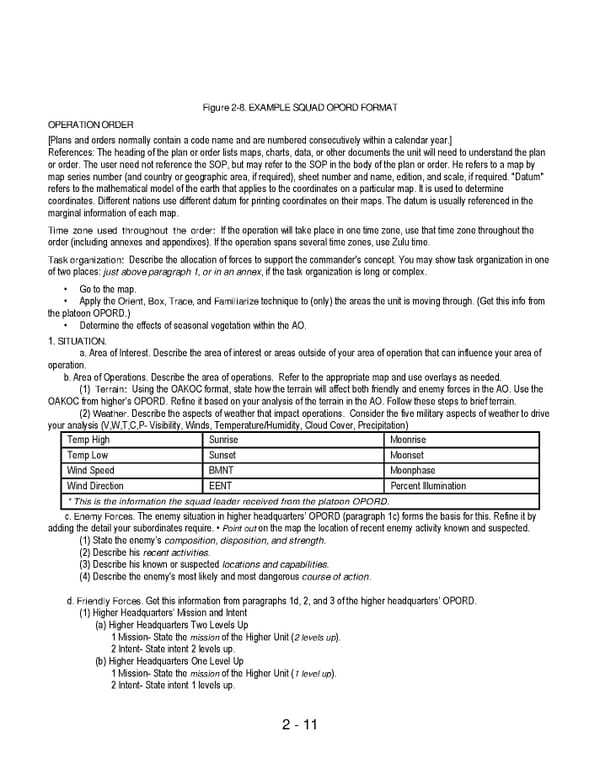2 - 11 Figure 2-8. EXAMPLE SQUAD OPORD FORMAT OPERATION ORDER [Plans and orders normally contain a code name and are numbered consecutively within a calendar year.] References: The heading of the plan or order lists maps, charts, data, or other documents the unit will need to understand the plan or order. The user need not reference the SOP, but may refer to the SOP in the body of the plan or order. He refers to a map by map series number (and country or geographic area, if required), sheet number and name, edition, and scale, if required. "Datum" refers to the mathematical model of the earth that applies to the coordinates on a particular map. It is used to determine coordinates. Different nations use different datum for printing coordinates on their maps. The datum is usually referenced in the marginal information of each map. Time zone used throughout the order: If the operation will take place in one time zone, use that time zone throughout the order (including annexes and appendixes). If the operation spans several time zones, use Zulu time. Task organization: Describe the allocation of forces to support the commander's concept. You may show task organization in one of two places: just above paragraph 1, or in an annex, if the task organization is long or complex. • Go to the map. • Apply the Orient, Box, Trace, and Familiarize technique to (only) the areas the unit is moving through. (Get this info from the platoon OPORD.) • Determine the effects of seasonal vegetation within the AO. 1. SITUATION. a. Area of Interest. Describe the area of interest or areas outside of your area of operation that can influence your area of operation. b. Area of Operations. Describe the area of operations. Refer to the appropriate map and use overlays as needed. (1) Terrain: Using the OAKOC format, state how the terrain will affect both friendly and enemy forces in the AO. Use the OAKOC from higher’s OPORD. Refine it based on your analysis of the terrain in the AO. Follow these steps to brief terrain. (2) Weather. Describe the aspects of weather that impact operations. Consider the five military aspects of weather to drive your analysis (V,W,T,C,P- Visibility, Winds, Temperature/Humidity, Cloud Cover, Precipitation) Temp High Sunrise Moonrise Temp Low Sunset Moonset Wind Speed BMNT Moonphase Wind Direction EENT Percent Illumination * This is the information the squad leader received from the platoon OPORD. c. Enemy Forces. The enemy situation in higher headquarters’ OPORD (paragraph 1c) forms the basis for this. Refine it by adding the detail your subordinates require. • Point out on the map the location of recent enemy activity known and suspected. (1) State the enemy’s composition, disposition, and strength. (2) Describe his recent activities. (3) Describe his known or suspected locations and capabilities. (4) Describe the enemy's most likely and most dangerous course of action. d. Friendly Forces. Get this information from paragraphs 1d, 2, and 3 of the higher headquarters’ OPORD. (1) Higher Headquarters’ Mission and Intent (a) Higher Headquarters Two Levels Up 1 Mission- State the mission of the Higher Unit (2 levels up). 2 Intent- State intent 2 levels up. (b) Higher Headquarters One Level Up 1 Mission- State the mission of the Higher Unit (1 level up). 2 Intent- State intent 1 levels up.
 Ranger Handbook Page 32 Page 34
Ranger Handbook Page 32 Page 34